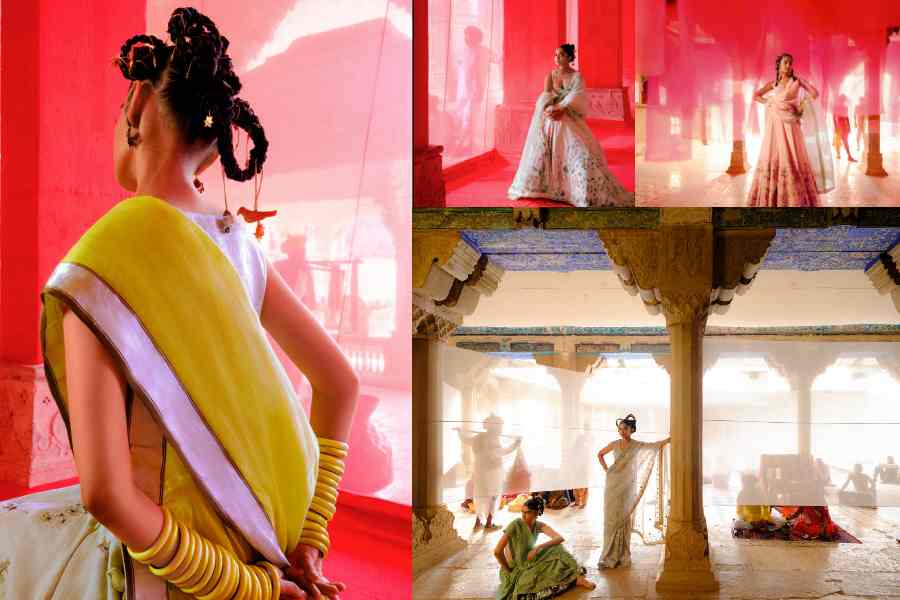Minimal luxury has always been Anavila Misra’s forte, marked by a certain understated elegance. Her first bridal collection, Aamod, has the same spirit and ‘lightness of being’. Nature-inspired, drawing heavily from Rajasthan’s Bundi Palace, lehngas, saris and kaftans in khadi silks, linen zari, with prints, embroidery, applique and leheriya, makes Aamod a poem about simple elegance. The embroidery has a painterly quality to it, adding to the romance. t2 chatted with Anavila about the making of Aamod.
Congratulations on your first bridal collection!
'Aamod' is actually a Sanskrit word which means ‘joy’. We’ve been getting requests from brides for a few years. I think the first bridal look we did was a metallic sari which was six-to-seven years ago, before Covid. Then we got a request for a garment, a lehnga or a sari. We’ve been doing this for one-off clients for a while. And, a lot of our clients say that they wore it to weddings, but some four-five clients wore it to their own weddings... they wanted specialised things that we made.
With our applique artisans, we actually complete over a decade and the whole vocabulary of that work has also increased over these years. So, we were ready to create something which takes us to another space which is more detailed and has more emphasis on craft. We right now do mostly loom-based textiles with a little bit of ornamentation. We were never heavy on ornamentation after the piece comes out. With this collection, the whole experience with our artisans who do applique and embroidery... kind of understanding the space now in a better way. We were very ready for this collection now.
Was the whole collection made in Rajasthan?
No, only the inspiration (came from Rajasthan) and a bit of the leheriyas. The application was done in different parts. For example, the applique I am talking about was done in Jharkhand, the weaving was done in West Bengal, part of the weaving was done in Benaras as well.
Who is an Anavila bride?
A bride with a point of view and not dancing to the tune that the bride has to be a certain way and the whole market caters to that one look or maybe those two looks. An Anavila bride is someone who wants to create her own look. For us, the very basis or premise of our brand is comfort and ease. It is something you feel nice about. Bridalwear is always very costume-y. You are looking elevated and detailed but how you feel inside is not so important, but you are ready to go through that pain to look a certain way.
For me, how you are feeling is as important as how you are looking. When you get dressed up for that particular evening to the time you are in those particular garments, you are part of that whole magic; rather than being a centrepiece and everybody else enjoying and you are thinking when it would get over (and you can get into comfortable clothes) (laughs)....
Even for my wedding, I wore a heavy lehnga because I also fell into that tune that this was how brides looked. For me, mobility, ease and comfort are very important. It, of course, goes without saying that it has to be luxury and beautifully crafted and the detailing has to be on point. I want to talk more and more to the people who want to wear this, the bride who wants to wear this, to be able to create a customised outfit, how can we create a dream for them, which is personal to them rather than making many pieces.
We have made a few pieces for the first edition, but they are open to interpretation. The pieces are not very heavy, because we have made sure that we have fabric applique and the fabric we have used is mostly cotton-silk.
There is a juxtaposition of the feminine and masculine in her...
When I say role reversal and taking new responsibilities... today you see the role of a girl child in the family is changing. You can be the one who takes forward the business and the son might want to do something completely different. If you see our campaign images, women are mostly in front and men are behind the veil, just to see how it feels, how the world looks from this space and how it can look from the other space. You can either say that you are looking through the veil or you can say it’s role reversal.
What did the Bundi Palace add to the whole campaign?
Bundi was the beginning of this collection. The frescoes on those walls were the inspirations for most of the works you see on our lehngas and garments, in terms of the colours and motifs. When we thought of shooting the collection, we thought of going back to the place where it all began. You’ve got inspired from that space and then you create inspiration in that space. We got all the local people to visit and be a part of the campaign.
Fashion is all about freedom, right, like wearing khadi silk for your wedding?
I feel fashion and style are very personal. The way women used to dress up 20, 30, 40 years ago, was for a different time and cultural space. Our society has gone through so much change. Women have a voice of their own. They are moving about and doing things which are very different from when a particular way was set for them to dress up. There is more space for individual interpretation of what you consider as fashion, what would work for you... there are no set rules.
